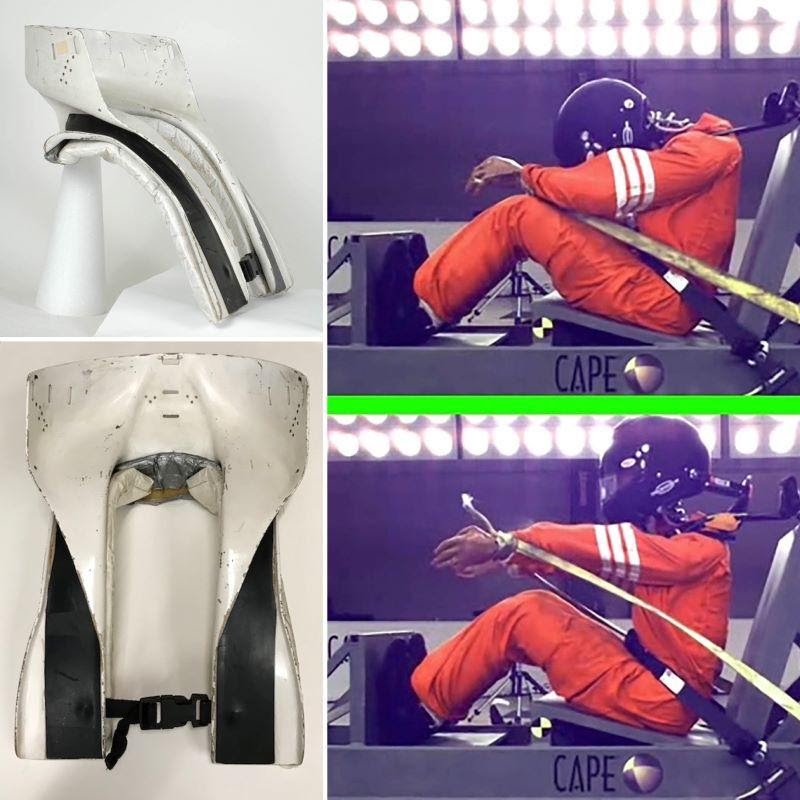New MSHFA Exhibit Celebrates HANS Device Anniversary

The first HANS device worn in competition at Daytona 35 years ago highlights a new safety exhibit at the Motorsports Hall of Fame of America (MSHFA) on the grounds of Daytona International Speedway, the museum announced. The exhibit opens on the 20th anniversary of the first full seasons when CART Indy car and NASCAR Cup Series drivers were mandated to wear a HANS device.
Five-time IMSA champion Jim Downing competed for the first time wearing a prototype version in the October 1986 3-hour IMSA season finale at Daytona. The HANS (Head And Neck Support) was needed because of increased speeds and, ironically, superior cockpit restraints. Basal skull fractures resulted when safety harnesses held a driver’s torso in place and the energy of a sudden stop in a high-speed crash was transferred to a helmeted head, resulting in head whip and sometimes deadly neck tension.
It took more than a decade to persuade sanctioning bodies to mandate racing’s first head restraint, the museum said. Following additional development to reduce its size, the HANS was mandated by CART for ovals during the 2001 season. NASCAR followed in the fall of 2001 after a series of fatalities from basal skull fractures, including Dale Earnhardt in the 2001 Daytona 500.
“When the lightweight and smaller HANS came out, F1 and CART jumped on it,” said Dr. Stephen Olvey. “As Director of Medical Affairs for IndyCar, I had to find a driver who would test the device for an extended period. Christian Fittipaldi agreed to take on the challenge during the winter test.”
“CART made the HANS mandatory on all oval tracks in 2001,” continued Olvey. “NASCAR made the HANS mandatory in October of 2001 with another device they were testing called the Hutchens device. In 2002 CART made the HANS mandatory for all races. Formula 1 adopted the HANS in 2003 and NASCAR stopped using the Hutchens device in 2005. Now nearly every serious racing driver wears a HANS device and nearly all professional series have made it mandatory. The risk of basilar skull fracture has now essentially disappeared.”
“We were very sure it was a serious safety device,” said Downing, who had first suggested to Dr. Robert Hubbard that motor racing needed a way to reduce head injuries. Hubbard, who died in 2019, was Downing’s brother-in-law and a professor of biomechanical engineering at Michigan State University.
The HANS, needed in high-speed crashes even with SAFER barriers, eventually helped end basal skull fractures in major league racing.
The sport’s first head restraint did not meet with immediate acceptance or approval, according to the MSHFA. Made of fiberglass and finished in white gelcoat, the device first worn by Downing at Daytona was dubbed the “Cinderella Collar.”
Sanctioning body mandates in series around the world as well as voluntary use in auto and boat racing eventually led to the production and sale of over 500,000 devices.
In addition to displaying the “Cinderella Collar,” the MSHFA exhibit chronicles the efforts of Hubbard and Downing to reduce the size of the HANS to make it universally applicable in all types of racing.
“We are grateful to Jim Downing and Jonathan Ingram, author of the book Crash! How the HANS Helped Save Auto Racing (2019) for making this exhibit possible,” said Motorsports Hall of Fame of America President George Levy. “Few devices in the history of the sport have contributed as much to saving lives.”
The “Cinderella Collar” was the first of the wraparound Model I devices. It was replaced by the carbon fiber Model I, which was dubbed the “Elvis Collar” in the IMSA paddock. Downing wore a HANS in every race following that 1986 debut including his LMP-2 class victory at Le Mans in 1996. But in the first 10 years after HANS Performance Products was launched by Hubbard and Downing in 1991, fewer than 300 were sold.
Another section of the MSHFA’s new safety exhibit pays tribute to 2003 inductee Bill Simpson, the museum said. NASA astronaut and racing buff Pete Conrad had introduced Simpson to a fire-resistant DuPont fabric called Nomex in 1967. Soon, Simpson’s Nomex fire suits were being worn by drivers everywhere. In the exhibit is one of the actual suits in which Simpson famously set himself on fire to demonstrate their life-saving properties.



